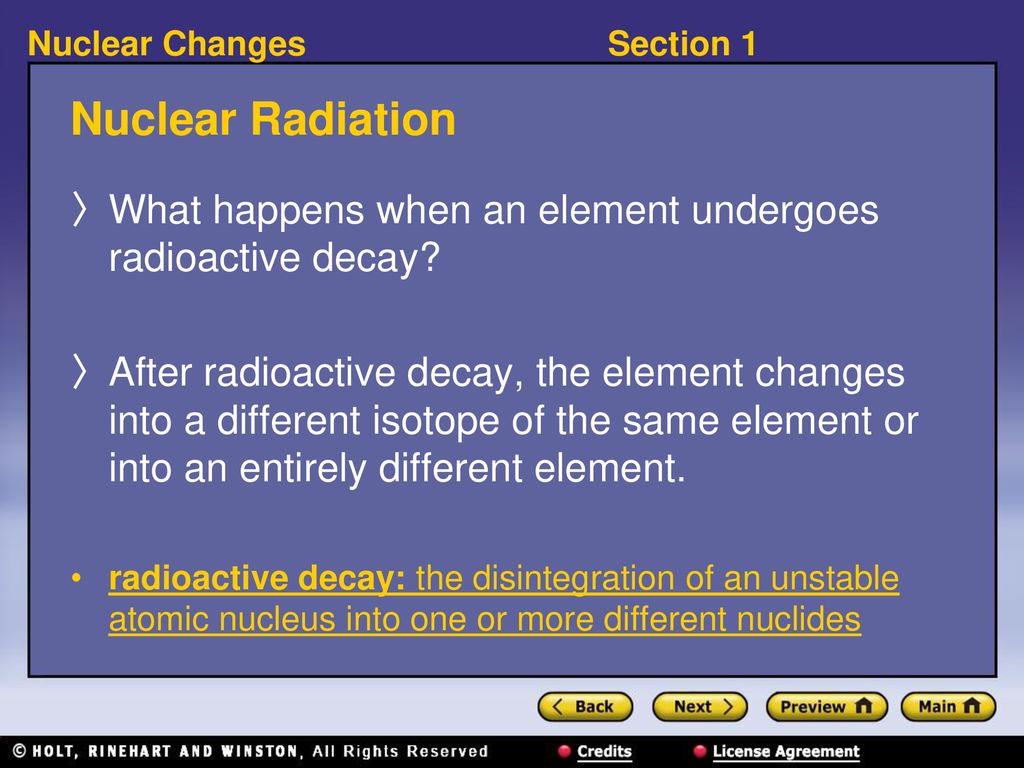The half-life of a radioisotope can be fractions of a second or millions of years depending on the element. An atoms nucleus can only be stable if it has a certain number of neutrons for the number of protons it has.

Radioactive Decay Nuclear Decay Processes Ppt
Radioactive decay also known as nuclear decay radioactivity radioactive disintegration or nuclear disintegration is the process by which an unstable atomic nucleus loses energy by radiationA material containing unstable nuclei is considered radioactiveThree of the most common types of decay are alpha decay beta decay and gamma decay all of which involve emitting one or more particles.

What happens to a radioisotope when it undergoes nuclear decay. Certain naturally occurring radioactive isotopes are unstable. Sometimes the product of that nuclear decay is unstable itself and undergoes nuclear decay too. Most radioactive atoms are heavy atoms and because theyre so heavy theyre unstable so they break down into one or several more stable smaller atoms and spit out the extra particles in the.
A It becomes a different element. This could be in the form of alpha beta or gamma particles. For reasons that are deeply related to the fundamental forces that act in the nucleus the tendency of a substance to undergo nuclear decay is related to both the atomic number and the atomic mass of an element.
In the case of radioactive decay instability occurs when there is an imbalance in the number of protons and neutrons in the atomic nucleus. Their nucleus breaks apart undergoing nuclear decay. D It emits charged particles but no energy.
When a radioactive atom undergoes a nuclear decay event the significant decay modes are alpha decay beta decay electron capture and spontaneous fission the decaying nucleus undergoes a transformation in identity associated with the change in the number of protons in the nucleus. This means that two different isotopes of the same element will have different tendencies to undergo nuclear decay. Alpha or beta emissions may result in a change in the number of protons within the nucleus.
For example when U-238 one of the radioactive isotopes of uranium initially decays it produces Th-234 which decays to Pa-234. Pb-206 is stable and the decay sequence or series stops. Which of these an atomic nucleus undergoes depends on the nature of the internal instability.
So from the given options option A is the correct answer. Read formulas definitions laws from first order radioactive decay here. During one-half life h alf of the sample undergoes radioactive decay.
Nuclear decay is a process in which an unstable radioisotope changes into another element through the emission of characteristic radiation which are essentially fast moving energetic particles. Nuclei with atomic number greater than _____ are radioactive. In alpha decay an alpha particle a helium nucleus is emitted from the radioactive atom and the atom therefore loses 2 protons and becomes a new element.
In radioactive decay an atom will lose protons and therefore forms new elements. There are three forms of radioactive decay. A radioisotope undergoing nuclear decay gives off particles from its nucleus turning it into a different isotope that may or may not be radioactive.
What happens to a radioisotope when it undergoes nuclear decay. Occasionally it is possible for a neutron to be emitted by radioactive decay. Basically there is too much energy inside the nucleus to hold all the nucleons together.
All radioactive decay events are spontaneous and therefore are. Their nucleus breaks apart undergoing nuclear decay. Become a member and.
C It remains stable. When an unstable isotope undergoes radioactive decay radiation is emitted in the form of either alpha beta or gamma particles. Get your answers by asking now.
8 The alpha decay of radon-198 9 The beta decay of uranium-237 10 Positron emission from silicon-26 11 Sodium-22 undergoes electron capture 12 Positron emission from boron-8 13 The alpha decay of. Its basically a matter of thermodynamics. 1 becquerel 1bq 1 radioactive decay per second 1 curie 1 ci 37 1010 bq.
The Process of Natural Radioactive Decay. ²³⁸U ²³⁴Th ⁴He. See full answer below.
The law of radioactive decay is probably the most important law of radioactivity. In this regard what happens in a radioactive decay. Half Life of a radioactive isotope is defined as the time in which one-half of its atom decay or disintegrate.
This can occur naturally ie absorption of cosmic rays high up in the atmosphere can result in neutron emission. Certain naturally occurring radioactive isotopes are unstable. Elements with fewer protons such as the ones near the top of the periodic table are.
Decay Practice Problems - Write the balanced equation for the following. When an unstable isotope undergoes radioactive decay radiation is emitted in the form of either alpha beta or gamma particles. The half-life of a radioactive element is the time that it takes for half the nuclei in the sample to decay in a first-order reaction.
For example a Uranium U-238 radioisotope gets converted to Thorium Th-234 nucleus through the release of alpha particles as shown below. Every atom seeks to be as stable as possible. This allows for the conversion of radium into radon for instance or of tritium into helium.
B It emits neutral particles and no energy. When a nucleus undergoes decay through the emission of an alpha particle or a beta electron it transforms. Sometimes the product of that nuclear decay is unstable itself and undergoes nuclear decay too.